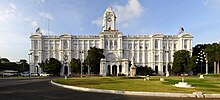
Municipal corporation
Municipal corporation is the legal term for a local governing body, including (but not necessarily limited to) cities, counties, towns, townships, charter townships, villages, and boroughs.[1] The term can also be used to describe municipally owned corporations.[1][2][3]

Municipal corporation as local self-government
Municipal incorporation occurs when such municipalities become self-governing entities under the laws of the state or province in which they are located. Often, this event is marked by the award or declaration of a municipal charter. A city charter or town charter or municipal charter is a legal document establishing a municipality, such as a city or town.[citation needed]

Bangladesh
There are 12 city corporations in Bangladesh. Two of these are in the capital Dhaka. Eight other divisional cities have a presence, three others.[clarification needed] They perform various socio-economic and civic functions. Besides, there are 330 municipal corporations in eight divisions of Bangladesh. A city corporation is a stronger body than a municipal corporation. This is because a city corporation consists of a metropolitan city of a district, and a municipal corporation consists of a municipal area of a sub-district.[4][5]

Canada
In Canada, charters are granted by provincial authorities.

India

The Greater Chennai Corporation is the oldest municipal corporation in the world outside the United Kingdom.[6]

Ireland
The title "corporation" was used in boroughs from soon after the Norman conquest until the Local Government Act 2001. Under the 2001 act, county boroughs were renamed "cities" and their corporations became "city councils"; other borough corporations were renamed "borough councils".[7]

After the Partition of Ireland, the corporations in the Irish Free State were Dublin, Cork, Limerick and Waterford (county boroughs) and Drogheda, Kilkenny, Sligo, Clonmel, and Wexford (non-county boroughs). Dún Laoghaire gained borough status in 1930 as "The Corporation of Dun Laoghaire".[8] Galway's borough status, lost in 1840, was restored in 1937; it was formally styled "the Mayor, Aldermen and Burgesses of the Borough of Galway",[9] but referred to as "the Corporation".[10]

New Zealand
The New Zealand Constitution Act 1852 allowed municipal corporations to be established within the new provinces of New Zealand. The term fell out of favour following the abolition of the provinces in 1876.[11]

United Kingdom
The ancient boroughs of England and Wales were typically incorporated by a royal charter, though some were boroughs by prescription. The Municipal Corporations Act 1835 and Municipal Corporations Act 1882 abolished the corporations of rotten boroughs and other small rural areas. The Local Government Act 1888 aligned the powers of the remaining borough corporations with those of the new urban district councils. All borough corporations were replaced under the Local Government Act 1972 with councils not designated as "corporations", with the exception of the City of London Corporation.

The corporations of the burghs of Scotland were similar in origin and were reformed or replaced in the nineteenth century before being abolished by the Local Government (Scotland) Act 1973. The Irish borough corporations within what is now Northern Ireland were reformed by the Municipal Corporations (Ireland) Act 1840 and Local Government (Ireland) Act 1898 and replaced by the Local Government Act (Northern Ireland) 1972.

United States
Most U.S. states and territories have at least two tiers of local government: counties and municipalities. Louisiana uses the term parish and Alaska uses the term borough for what the U.S. Census Bureau terms county equivalents in those states. Civil townships or towns are used as subdivisions of a county in 20 states, mostly in the Northeast and Midwest.

Population centers may be organized into incorporated municipalities of several types, including the city, town, borough, and village. The types and nature of these municipal entities vary from state to state. In addition to these general-purpose local governments, states may also create special-purpose local governments. Depending on the state, local governments may operate under their own charters or under general law, or a state may have a mix of chartered and general-law local governments. Generally, in a state having both chartered and general-law local governments, the chartered local governments have more local autonomy and home rule. Municipalities are typically subordinate to a county government, with some exceptions. Certain cities, for example, have consolidated with their county government as consolidated city-counties. In Virginia, cities are completely independent from the county in which they would otherwise be a part. In some states, particularly in New England, towns form the primary unit of local government below the state level, in some cases eliminating the need for county government entirely. Many rural areas and even some suburban areas of many states have no municipal government below the county level.

In addition to counties and municipalities, states often create special purpose authorities, such as school districts and districts for fire protection, sanitary sewer service, public transportation, public libraries, public parks or forests, water resource management, and conservation districts. Such special purpose districts may encompass areas in multiple municipalities or counties. According to the US Census Bureau's data collected in 2012, there were 89,004 local government units in the United States. This data shows a decline from 89,476 units since the last census of local governments performed in 2007.

Each of the five permanently inhabited U.S. territories is also subdivided into smaller entities. Puerto Rico has 78 municipalities, and the Northern Mariana Islands has four municipalities. Guam has villages, the U.S. Virgin Islands has districts, and American Samoa has districts and unorganized atolls.

Each Indian Reservation is subdivided in various ways. For example, the Navajo Nation is subdivided into agencies and chapter houses, while the Blackfeet Nation is subdivided into communities.

Municipal corporations as enterprises
According to one definition of the term, municipal corporations are "organisations with independent corporate status, managed by an executive board appointed primarily by local government officials, and with majority public ownership".[1] Some such corporations rely on revenue from user fees, distinguishing them from agencies and special districts funded through taxation,[2] although this is not always the case.[1] Such municipal corporations result from a process of "externalization", and require different skills and orientations from the respective local governments, and follow common changes[clarification needed] in the institutional landscape of public services.[3] They are argued to be more efficient than government bureaucracies, but have higher failure rates because of their legal and managerial autonomy.[1]

See also
References
- ^ a b c d e Voorn, Bart; Van Genugten, Marieke L.; van Thiel, Sandra (2017). "The efficiency and effectiveness of municipally owned corporations: A systematic review" (PDF). Local Government Studies. 43 (5): 820–841. doi:10.1080/03003930.2017.1319360. hdl:2066/176125.
- ^ a b Tavares, Antonio F.; Camoes, Pedro J. (2007). "Local service delivery choices in Portugal: A political transaction costs network". Local Government Studies. 33 (4): 535–553. doi:10.1080/03003930701417544. S2CID 154709321.
- ^ a b Grossi, G.; Reichard, C. (2008). "Municipal corporatization in Germany and Italy". Public Management Review. 10 (5): 597–617. doi:10.1080/14719030802264275. S2CID 153354582.
- ^ "Making City Corporation effective".
- ^ "Facilities of city corporations' councilors being increased by manifold". 12 February 2023.
- ^ "The first corporation". The Hindu. Chennai. 2003-04-02. Archived from the original on 2004-01-28. Retrieved 14 April 2012.
- ^ "Local Government Act, 2001". Irish Statute Book. p. §11(3), §11(4), Schedule 2. Archived from the original on 4 February 2014. Retrieved 13 May 2014.
- ^ "Local Government (Dublin) Act, 1930, Section 3". Irish Statute Book. Retrieved 13 May 2014.
- ^ "Local Government (Galway) Act, 1937, Section 3". Irish Statute Book. Retrieved 13 May 2014.
- ^ "Local Government (Galway) Act, 1937, Section 2". Irish Statute Book. Retrieved 13 May 2014.
- ^ "New Zealand Constitution Act 1852". Victoria University of Wellington - New Zealand Electronic Text Collection. 30 June 1852. Retrieved 2 April 2019.
External links
Municipal incorporation
- "Characteristics and State Requirements for Incorporated Places" - United States Census
Municipal disincorporation/dissolution
- "Municipal Disincorporation in California" - California City Finance
See what we do next...
OR
By submitting your email or phone number, you're giving mschf permission to send you email and/or recurring marketing texts. Data rates may apply. Text stop to cancel, help for help.
Success: You're subscribed now !
